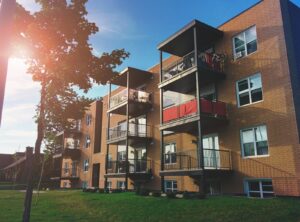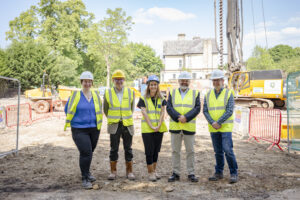 New Start speaks to Professor Paul Watt (pictured) from the Department of Geography, Birbeck College, University of London about his new book, Estate Regeneration and Its Discontent – Public Housing, Place and Inequality in London.
New Start speaks to Professor Paul Watt (pictured) from the Department of Geography, Birbeck College, University of London about his new book, Estate Regeneration and Its Discontent – Public Housing, Place and Inequality in London.
Based on extensive fieldwork and interviews with more than 200 residents living in some of the capital’s most deprived areas, Watt shows the dramatic ways that estate regeneration is reshaping London, fuelling socio-spatial inequalities via state-led gentrification.
Foregrounding resident experiences and perspectives both before and during regeneration, he examines class, place belonging, home and neighbourhood, and argues that the endless regeneration process results in degeneration, displacement and fragmented communities.
New Start: What was the genesis for your book?
Paul Watt: ‘I first became interested in council housing during the 1980s, and subsequently completed a PhD on local authority housing in the London Borough of Camden. From then, I went onto do research on stock transfers from councils to housing associations in the boroughs of Tower Hamlets and Lambeth during the 2000s. In 2010, I began a longitudinal project looking at homelessness in Newham, particularly looking at the impact of the London 2012 Olympic Games on low-income youth. As a result of that, I became aware of the Carpenters Estate, which is just right next to Stratford train station in Newham. It’s a complex story, but back in the early 2000s, residents in the Carpenters’ tower blocks had formed a protest group to pressurise the council to improve their housing conditions. A regeneration plan was subsequently put in place which initially involved the partial demolition of the estate, and many tenants were ‘decanted’, as per the jargon. From research at this estate, plus the earlier stock transfer research, it became clear to me that estate regeneration was in reality not delivering what was promised or claimed by officials and politicians, and certainly not so from the residents’ perspective.
‘From 2012 to 2018, I proceeded to look at several estates across London which were at various stages of regeneration. Some of these involved highly controversial regeneration schemes, such as the Haringey Development Vehicle which targeted Northumberland Park Estate in Tottenham. I attended over 300 housing and regeneration-related meetings and events, and interviewed over 200 residents and officials in order to try and understand those regeneration schemes that involved either partial or complete demolition of an estate. The book itself has three main aims. Firstly, to outline and explain the housing and urban policy context within which estate generation takes place. Secondly, to understand what residents’ experiences of living at estates are like before regeneration occurs. And thirdly, to examine residents’ experiences of living through regeneration as a lengthy process which unfolds over many years of their lives.’
You’ve interviewed more than 200 people for the book. What were the main reasons from residents’ perspective for opposing regeneration projects?’
Because of systemic underfunding and poor maintenance over the years, many social housing tenants want to see improvements, for example they want the public spaces and their homes to be properly maintained. But the problem is how 21st century estate regeneration schemes develop along lines that don’t really square with residents’ notions of their homes and neighbourhoods. The rationale for estate regeneration is all too often that these are terrible places to live which need to be knocked down. While there are certainly problematic issues in many London social housing estates – for example overcrowding, inadequate repairs, and in some cases fear of crime and antisocial behaviour – that doesn’t mean to say residents want a “scorched Earth” redevelopment involving large-scale demolition. Residents want some reinvestment, and they want their landlords take a much more proactive approach in terms of fixing those things that need to be fixed. However, estate regeneration develops in a manner that produces all kind of negative results that residents were not originally made aware of, not least the sheer length of time that the process takes.
‘Estate regeneration takes many years from start to finish, even up to 30 years at some of the larger estates. Because the process takes so long and because it’s so convoluted, many residents experience what can be termed ‘degeneration’. Estates degenerate in a whole variety of ways including managed decline, loss of neighbourhood facilities, residents live on a building site, while properties become empty and boarded-up as tenants are decanted. All the familiar faces that long-term tenants and leaseholders have known for years begin to disappear, so the remaining residents are thrust into an alien world of transient strangers – squatters, temporary tenants and property guardians – who either officially or unofficially repopulate the empty properties. To add insult to injury, the half-empty estates become location sets for dystopian films and TV programmes about gangsters and urban collapse, as famously happened at the Heygate Estate in Southwark.’
Through your studies, were there any examples of estate regeneration you found that worked?
‘There are three ways to answer that. First, estate regeneration schemes that began in the early 1990s, like the Comprehensive Estates Initiative (CEI) in Hackney which was focused on five estates including Holly Street, were completed within around ten years. They were largely publicly funded, and tended to reduce density. If you look at the tenure results of those early schemes, you can see that social tenants remain in the majority in the redeveloped neighbourhoods. Those early schemes are quite distinct from the later schemes – such as Woodberry Down, West Hendon and the Heygate – which were begun during the New Labour years and which are the main focus of the book. These later schemes rely heavily upon private-sector funding, and secondly they are framed within New Labour’s ‘mixed and sustainable communities’ urban policy approach. So, the end results have been quite different since any remaining social tenants are squeezed into largely private, upmarket neighbourhoods such as Elephant Park, the now rebranded and redeveloped Heygate Estate. In other words, such estate regeneration is effectively what can be termed state-led gentrification. I’m not saying the early schemes, like the Hackney CEI, were problem free, but the housing tenure results were quite different. Second, is that certain aspects of major regeneration programmes in London – such as the New Deal for Communities – did provide genuine community benefits, such as reduced crime and fear of crime, for example at the Aylesbury and Clapham Park estates, even if the housing-related aspects were far less successful. Third, is that refurbishment-only regeneration schemes have the potential to bring about positive housing outcomes while avoiding the massive degeneration impacts and damaging environmental effects that demolition-and-rebuild schemes bring about, as various reports by researchers from UCL and the London School of Economics strongly suggest.’
Estate Regeneration and Its Discontents – Public Housing, Place and Inequality in London is available now from Bristol University Press.


















Leave a Reply